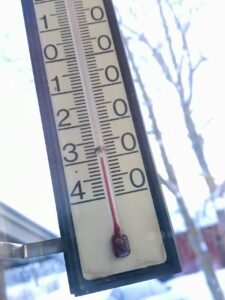When you have are preparing for low temperatures it is not only the temperature that decides, but also wind and possible precipitation. When it is windy, the cooling effect increases, but at the same time it is good to know that in our Arctic area the air is usually still when it is really cold, –20C or even –35C (–4F/–31F).
It is an experience to go from a hot sauna to standing outdoors in minus 20 degrees with just a towel around your body. The hot steam rises like a pillar of smoke, but the cooling effect is no worse than giving you time to study the stars – and perhaps discover the dance of the Aurora/Northern lights across the sky.
When it comes to dressing for cold climate my strategy is to dress for lower temperatures than I expect. If the weather report says minus 10, I dress for minus 20. It’s easier to lighten a scarf or collar to ventilate away heat, than to strengthen the layers of clothing out in the nature.
My strategy is also to dress like an onion. You should use be many layers. It gives the best effect.
It is also important to use natural materials that breathe. Cotton works in a t-shirt on a sunny beach, but has nothing on the body to do when the temperature creeps down. Personally, I prefer modern wool products closest to the body. They are comfortable to wear and warm even if they get damp. Underwear made of polyester and plastic fiber I avoid. They need to be washed often, otherwise they start to smell rotten onions.
The dress code in the Arctic climate is to dress like an onion, with many layers.
Head & neck:
The most important parts of the body. Here you need a hat that goes down over the ears. It can be supplemented with a baklava that goes down over the neck. With a scarf, it is easy to lighten the outfit if you get too warm.
Upper body:
Layer 1: A wool undergarment (cotton is not recommended).
Layer 2: A sweater in wool or micro-fleeze (again: cotton is not recommended).
Layer 3: A ski jacket of windstopper model (thick down jacket is not recommended if you want to use an overall on top of everything, for example a snowmobile safari).
Hands:
Gloves for alpine skiing usually work well and if your gloves have both inner and outer gloves, it is excellent. If the gloves have a collar, it can be folded down to ventilate the wrists, in case you get too warm in the body.
Lower body:
Panties/underpants, preferably of wool material. (Once you start to use them, cotton or plastic materials will make you uncomfortable).
Layer 1: Long underwear made of wool material (cotton is suitable for rags).
Layer 2: Mid layer in wool or micro-fleece.
Layer 3: Windstopper model ski pants.
Feets:
Thin socks in wool, medium-thick socks in wool and then thicker wool socks. Always choose winter shoes that are a couple of sizes larger than what you normally use. If it gets tight, it gets cold. Bigger is better!
For both your upper and lower body, an additional layer can be added.
At Filipsborg, we have Arctic clothes for our hotel guests for rent: overalls, hats, gloves and shoes adapted to be able to enjoy the Arctic climate. If you have questions about the choice of clothing, you are welcome to contact us.
Örjan Pekka
Owner/hotel manager/Storyteller at Filipsborg

–30C.




/https%3A%2F%2Fcoastallapland.ohmyhosting.se%2Fwp-content%2Fuploads%2Fsites%2F2%2Fflags%2FUK.jpg)
/https%3A%2F%2Fcoastallapland.ohmyhosting.se%2Fwp-content%2Fplugins%2Fsitepress-multilingual-cms%2Fres%2Fflags%2Fde.png)
/https%3A%2F%2Fcoastallapland.ohmyhosting.se%2Fwp-content%2Fuploads%2Fsites%2F2%2Fflags%2FSweden.jpg)
/https%3A%2F%2Fcoastallapland.ohmyhosting.se%2Fwp-content%2Fuploads%2Fsites%2F2%2F2021%2F05%2Fdecember-18-12-26_12-57-46.jpg)